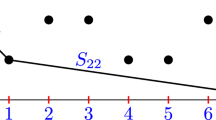Abstract
We provide new bounds for the divisibility function of the free group \({\mathbf F}_2\) and construct short laws for the symmetric groups \({{\mathrm{Sym}}}(n)\). The construction is random and relies on the classification of the finite simple groups. We also give bounds on the length of laws for finite simple groups of Lie type.
Similar content being viewed by others
References
Amitsur, A.S., Levitzki, J.: Minimal identities for algebras. Proc. Am. Math. Soc. 1, 449–463 (1950). http://www.ams.org/journals/proc/1950-001-04/S0002-9939-1950-0036751-9/home.html
Babai, L., Seress, Á: On the diameter of permutation groups. Eur. J. Comb. 13(4), 231–243 (1992). http://www.sciencedirect.com/science/article/pii/S0195669805800290
Bou-Rabee, K.: Quantifying residual finiteness. J. Algebra 323(3), 729–737 (2010). http://www.sciencedirect.com/science/article/pii/S0021869309005882. arXiv:0807.0862
Bou-Rabee, K., McReynolds, D.B.: Asymptotic growth and least common multiples in groups. Bull. Lond. Math. Soc. 43(6), 1059–1068 (2011). http://blms.oxfordjournals.org/content/43/6/1059. arXiv:0907.3681
Breuillard, E., Green, B., Tao, T.: Approximate subgroups of linear groups. Geom. Funct. Anal. 21(4), 774–819 (2011). http://link.springer.com/article/10.1007%2Fs00039-011-0122-y. arXiv:1005.1881
Buskin, N.V.: Economical separability in free groups. Sibirsk. Mat. Zh. 50(4), 765–771 (2009) (Russian, with Russian summary); English transl., Sib. Math. J. 50(4), 603–608 (2009). English available at: http://link.springer.com/article/10.1007%2Fs11202-009-0067-7. Russian available at: http://www.emis.de/journals/SMZ/2009/04/765.html
Carter, R.W.: Simple groups of Lie type. Pure and Applied Mathematics, vol. 28. Wiley, London, New York, Sydney (1972)
Elkasapy, A., Thom, A.: On the length of the shortest non-trivial element in the derived and the lower central series . J. Group Geography (2015, to appear). arXiv:1311.0138
Diaconis, P., Saloff-Coste, L.: Comparison techniques for random walk on finite groups. Ann. Probab. 21(4), 2131–2156 (1993). http://www.jstor.org/stable/2244713
Gimadeev, R.A., Vyalyi, M.N.: Identical relations in symmetric groups and separating words with reversible automata, Computer science theory and applications. Lecture Notes in Comput. Sci., vol. 6072, pp. 144–155. Springer, Berlin (2010). http://link.springer.com/chapter/10.1007%2F978-3-642-13182-0_14
Gorenstein, D., Lyons, R., Solomon, R.: The classification of the finite simple groups. Mathematical surveys and monographs, vol. 40. American Mathematical Society, Providence (1994)
Guest, S., Morris, J., Praeger, C., Spiga, P.: On the maximum orders of elements of finite almost simple groups and primitive permutation groups. Trans. Am. Math. Soc. (2013) (to appear). arXiv:1301.5166
Guest, S., Spiga, P.: Finite primitive groups and regular orbits of group elements (in preparation)
Giudici, M., Praeger, C., Spiga, P.: Finite primitive permutation groups and regular cycles of their elements (2013) (preprint). arXiv:1311.3906
Hadad, U.: On the shortest identity in finite simple groups of Lie type. J. Group Theory 14(1), 37–47 (2011). http://www.degruyter.com/view/j/jgth.2011.14.issue-1/jgt.2010.039/jgt.2010.039.xml. arXiv:0808.0622
Helfgott, H., Seress, Á: On the diameter of permutation groups. Ann. Math. 179(2), 611–658 (2014). http://annals.math.princeton.edu/2014/179-2/p04. arXiv:1109.3550
Kassabov, M., Matucci, F.: Bounding the residual finiteness of free groups. Proc. Am. Math. Soc. 139(7), 2281–2286 (2011). http://www.ams.org/jourcgi/jour-getitem?pii=S0002-9939-2011-10967-5. arXiv:0912.2368
Landau, E.: Über die Maximalordnung der Permutationen gegebenen Grades. Archiv der Math. und Phys. 92–103 (1903). https://archive.org/details/archivdermathem48grungoog
Larsen, M.J., Pink, R.: Finite subgroups of algebraic groups. J. Am. Math. Soc. 24(4), 1105–1158 (2011). http://www.ams.org/jourcgi/jour-getitem?pii=S0894-0347-2011-00695-4
Liebeck, M.W.: On minimal degrees and base sizes of primitive permutation groups. Arch. Math. (Basel) 43(1), 11–15 (1984). http://link.springer.com/article/10.1007%2FBF01193603
Magnus, W., Karrass, A., Solitar, D.: Combinatorial group theory, 2nd revised edn. Dover Publications Inc, New York (1976)
Maróti, A.: On the orders of primitive groups. J. Algebra 258(2), 631–640 (2002). http://www.sciencedirect.com/science/article/pii/S0021869302006464
Mazurov, V.D., Khukhro, E.I. (eds.): The Kourovka notebook, 16th edn. Russian Academy of Sciences Siberian Division Institute of Mathematics, Novosibirsk (2006). arXiv:1401.0300
Nori, M.V.: On subgroups of \(\text{ GL }_{n}(\text{ F }_p)\). Invent. Math. 88(2), 257–275 (1987). http://link.springer.com/article/10.1007%2FBF01388909
Pyber, L., Szabó, E.: Growth in finite simple groups of Lie type (2010) (preprint). arXiv:1001.4556
Schützenberger, M.P.: Sur l’équation \(\text{ a }^{2+n} = \text{ b }^{2+m}c^{2+p}\) dans un groupe libre. C. R. Acad. Sci. Paris 248, 2435–2436 (1959) (French). http://gallica.bnf.fr/ark:/12148/bpt6k7304/f547
Serre, J.P.: Trees. Springer Monographs in Mathematics. Springer, Berlin (2003)
Thom, A.: Convergent sequences in discrete groups. Canad. Math. Bull. 56(2), 424–433 (2013). http://cms.math.ca/10.4153/CMB-2011-155-3. arXiv:1003.4093
Acknowledgments
This note was written during the trimester on Random Walks and Asymptotic Geometry of Groups at Institute Henri Poincaré in Paris. We are grateful to this institution for its hospitality. We are grateful to Mark Sapir for interesting remarks—especially about the comparison with the study of identities for associative algebras, and for bringing the work of Gimadeev–Vyalyi [10] to our attention. The second author thanks Emmanuel Breuillard and Martin Kassabov for valuable comments. The first author was supported by the Israel Science Foundation and the Jesselson Foundation. The second author was supported by ERC Starting Grant No. 277728.
Author information
Authors and Affiliations
Corresponding author
Rights and permissions
About this article
Cite this article
Kozma, G., Thom, A. Divisibility and laws in finite simple groups. Math. Ann. 364, 79–95 (2016). https://doi.org/10.1007/s00208-015-1201-4
Received:
Revised:
Published:
Issue Date:
DOI: https://doi.org/10.1007/s00208-015-1201-4



